
1introjunos
.pdf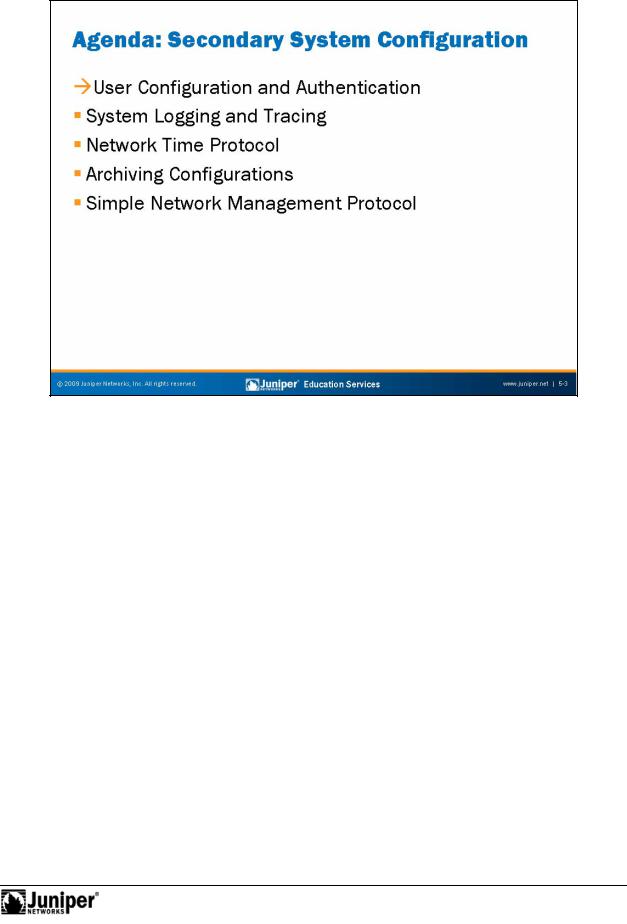
Not
Introduction to JUNOS Software
User ConfigurationReproductionand Authentication
The slide lists the topics we cover in this chapter. We discuss the highlighted topic
first. for
Secondary System Configuration • Chapter 5–3
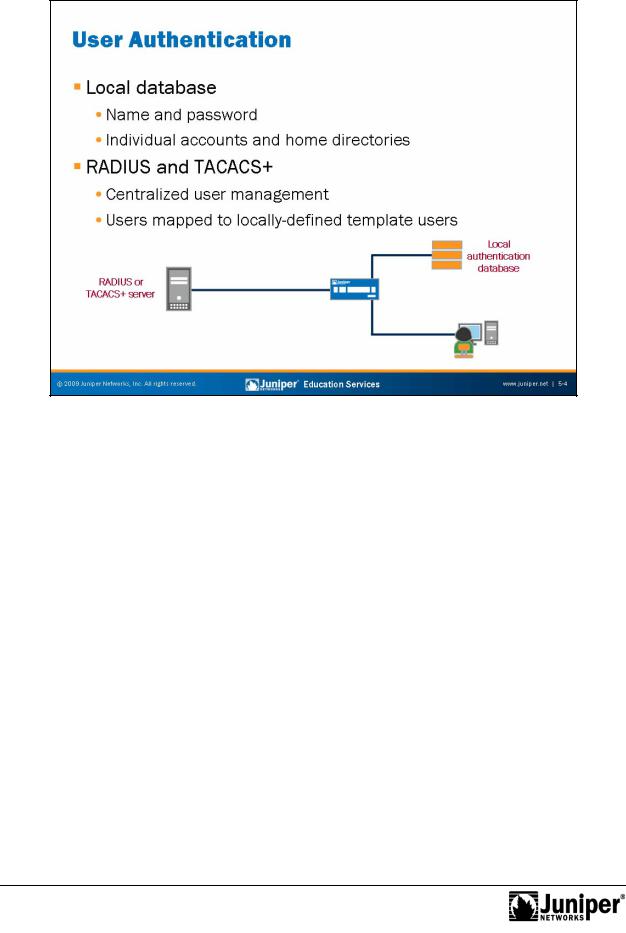
Introduction to JUNOS Software
Local Password Auth ntication
With local password authentication, you can configure usernames and passwords
individually |
each user to log in to a device running JUNOS Software. JUNOS |
Software enfo ces the following password restrictions: |
|
• |
Reproduction |
The password must be at least 6 characters; |
|
• |
Y u can include most character classes in a password (alphabetic, |
fornumeric, and special characters), except control characters; and |
|
• |
Passwords must contain at least one change of case or character class. |
NotWhen a user is configured on a device running JUNOS Software, the system automatically generates a home directory for that user. The home directory serves as the default working directory for each locally configured user. The user’s working directory can be changed for individual sessions using the operational mode set cli directory directory command.
Continued on next page.
Chapter 5–4 • Secondary System Configuration

Introduction to JUNOS Software
RADIUS and TACACS+
RADIUS and TACACS+ are distributed client and server systems used as authentication methods to validate users. The RADIUS and TACACS+ clients run on devices running JUNOS Software; the server runs on a host connected to a remote network. A locally defined user account determines authorization. Multiple RADIUS or TACACS+ authenticated users can be mapped to a locally defined template user account. Local template user accounts avoid the need for each RADIUS or TACACS+ user to also have a locally defined user account. With the appropriate Juniper Networks extensions loaded on the server, both RADIUS and TACACS+ can override these template user authorization parameters by passing extended regular expressions. Coverage of regular expressions is outside of the scope of this class.
|
for |
Reproduction |
Not |
|
|
|
|
Secondary System Configuration • Chapter 5–5
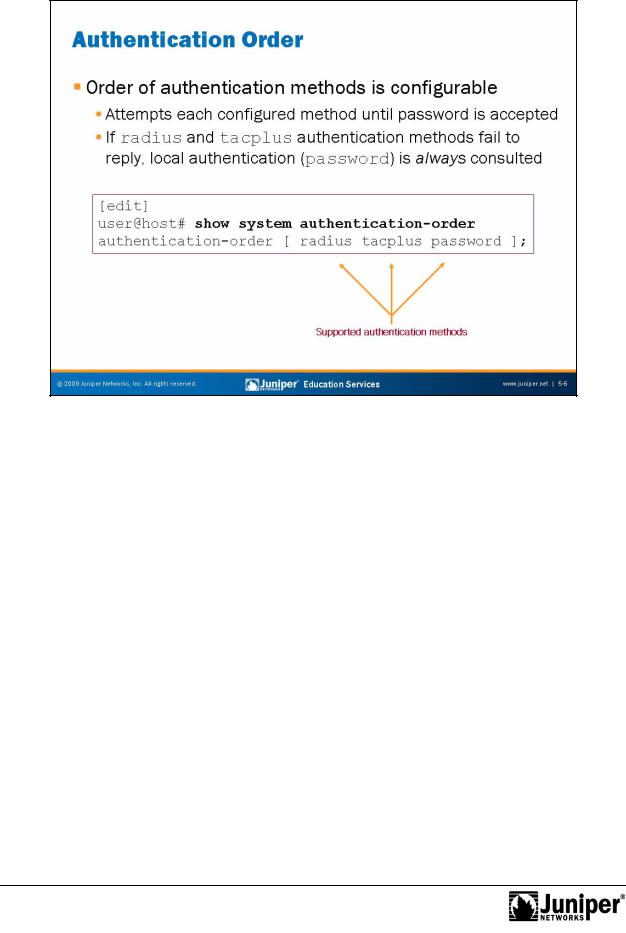
Introduction to JUNOS Software
Authentication OrderReproduction
You can configure devices running JUNOS Software to be both a RADIUS and TACACS+ client, andforyou can p io itize the order in which the software tries one or more of the three different authentication methods.
For each l gin attempt, JUNOS Software tries the authentication methods in order, until the passw rd is accepted. The next method in the authentication order is
Notconsul ed if the previous authentication method failed to reply or if the method rejec ed he login attempt. If no reply (accept or reject) is received from any of the
listed authentication methods, JUNOS Software consults local authentication as a last res rt.
Chapter 5–6 • Secondary System Configuration
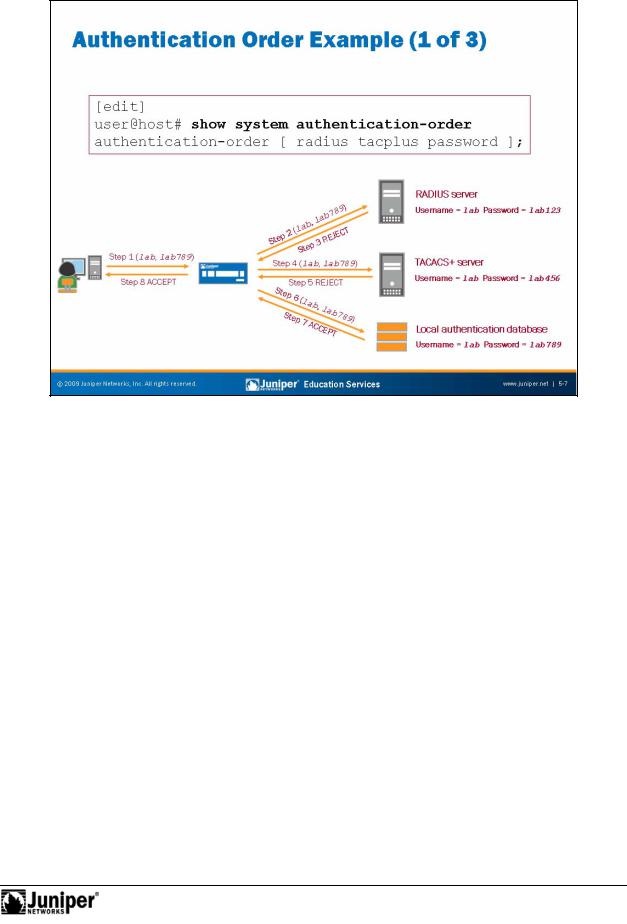
Introduction to JUNOS Software
In the exampleReproductionshown the slide, we configured authentication-order [ radius tacplus password ]. We entered a username of lab and a
passwoford of lab789. We successfully authenticated because each configured authentication method is attempted until the password is accepted by the local authentication database.
In addition to the authentication order shown on the slide, you would also need to Notconfigure the RADIUS and TACACS+ servers as well as the lab user. The following is a
sample of these configuration parameters:
[edit system]
user@host# show radius-server
172.18.102.13 secret "$9$9ZKntpBvMX7Nb1RcleW-dbs2gaU"; ## SECRET-DATA
[edit system]
user@host# show tacplus-server
172.17.32.14 secret "$9$m5T31Icyrvn/A0ORlevWLXNb"; ## SECRET-DATA
[edit system]
user@host# show login user lab class super-user; authentication {
encrypted-password "$1$dJ3NA9BW$nZGLZAp9kpiG52kru34IT."; ## SECRET-DATA
}
Secondary System Configuration • Chapter 5–7
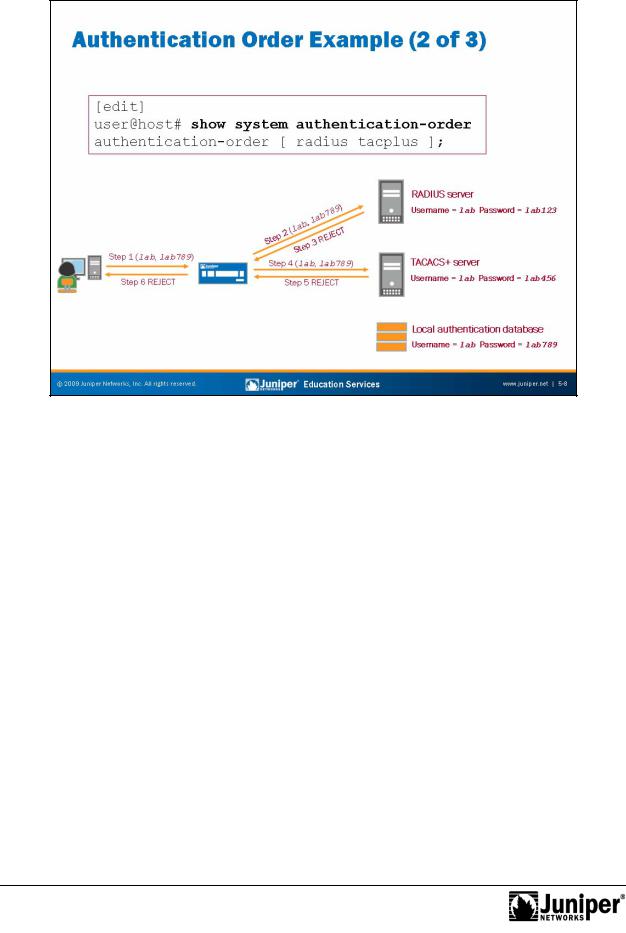
Introduction to JUNOS Software
In this example, we configuredReproductionauthentication-order [ radius tacplus ]. We ente ed a username of lab and a password of lab789. JUNOS
Software attempted to authenticate the password against the RADIUS server, which rejectedforit. It then attempted to authenticate the password against the TACACS+ server, which also rejected it. JUNOS Software does not consult local authentication
Notbecause it is n t listed in the authentication order, and because at least one of the configured authentication methods did respond. The password was rejected.
Chapter 5–8 • Secondary System Configuration
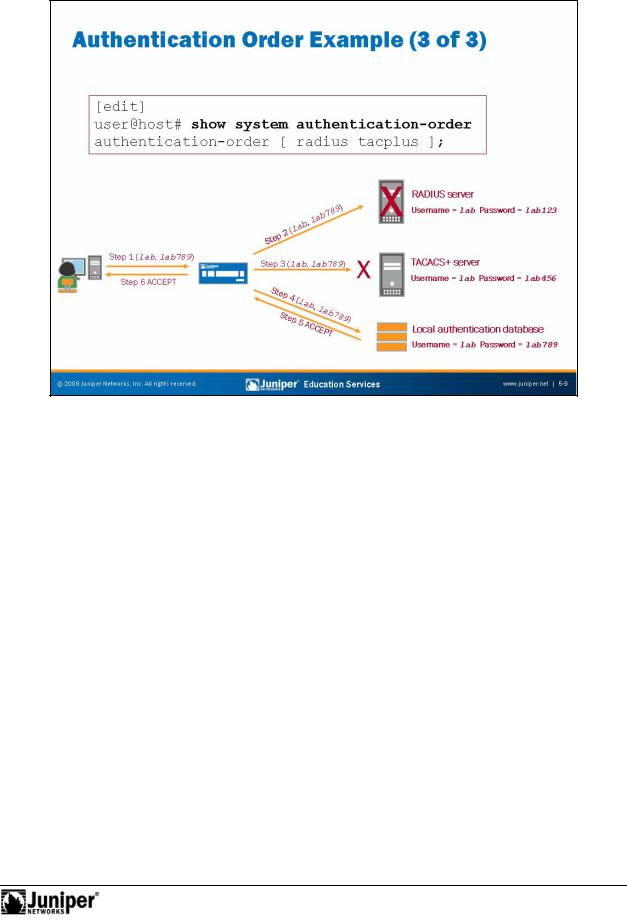
Introduction to JUNOS Software
In this example,Reproductionauthentication-order [ radius tacplus ] is still configu ed. We entered a username of lab and a password of lab789. JUNOS
forperi d, tried the TACACS+ server. A temporary network problem caused the TACACS+ server to be unreachable. After a timeout period, local authentication was consulted
Softwa e attempted to authenticate the password against the RADIUS server, which is d wn. The device running JUNOS Software received no response, and after a timeout
Notand the password was accepted. JUNOS Software consulted local authentication because none of the configured authentication methods responded.
Secondary System Configuration • Chapter 5–9
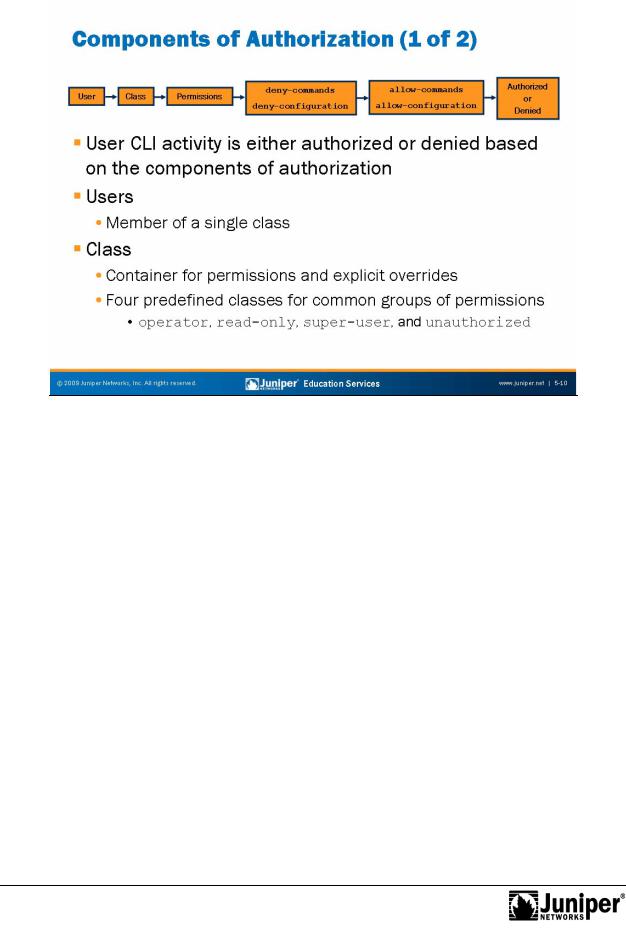
Introduction to JUNOS Software
|
interface (CLI). A c nfiguredReproductionhierarchy of authorization components, as shown |
|
by the |
|
|
|
|||
|
Authorization Overvi w |
|||
|
Each command or configuration statemen is subject to authorization. JUNOS |
|||
|
|
for |
||
|
Software applies autho ization to all nonroot users, and you cannot disable this |
|||
|
feature. Autho ization applies to both the J-Web interface and the command-line |
|||
|
graphic on the slide, defines whether a command is authorized. |
|||
|
Not |
|||
|
Users |
|
|
|
At the highest level, the configuration of user accounts define authorization parameters. As previously mentioned, multiple remotely authenticated users can be mapped to a locally defined template user. Users are members of a single login class.
Continued on next page.
Chapter 5–10 • Secondary System Configuration

Introduction to JUNOS Software
Class
A login class is a named container that groups together a set of one or more permission flags. Login classes can also specify that the permission flags should be overridden for certain commands. You can configure custom login classes, but there are four predefined login classes that exist to handle most situations. These classes and associated permission flags are the following:
•super-user: All permissions;
•operator: Clear, network, reset, trace, and view permissions;
•read-only: View permissions; and
•unauthorized: No permissions.
|
for |
Reproduction |
Not |
|
|
|
|
Secondary System Configuration • Chapter 5–11
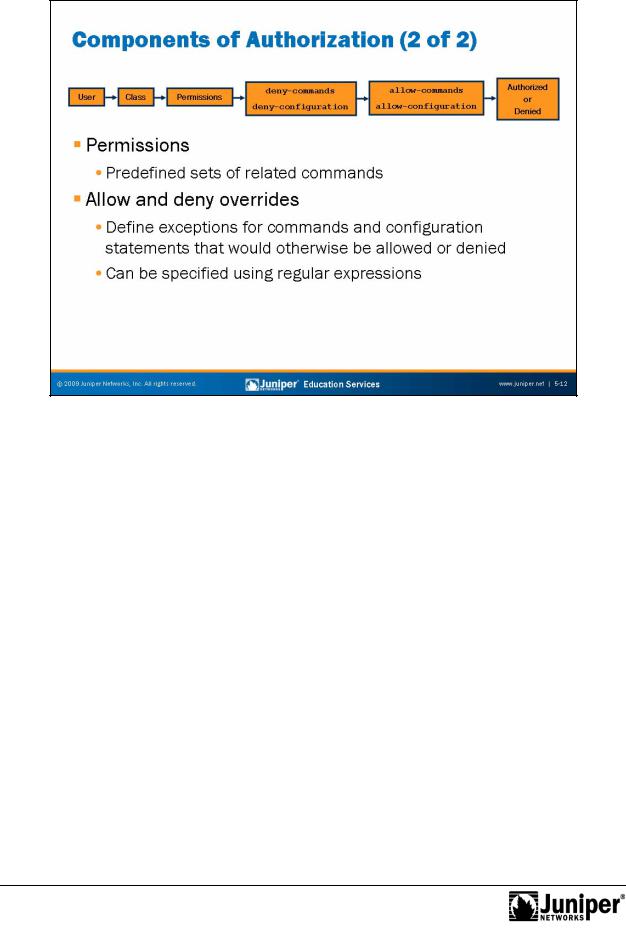
Introduction to JUNOS Software
Permissions Reproduction
The following predefined permission flags grou together the authorization of related commands:
foraccess: Allows the viewing of network access configuration;
access-control: Allows the modifying of network access c nfiguration;
admin: Allows the viewing of user accounts; admin-control: Allows the modifying of user accounts; all: Enables all permission bits to be turned on;
clear: Allows the clearing of learned network information; configure: Allows the entering of configuration mode;
control: Allows the modifying of any configuration values (must be used in conjunction with the configure permission);
field: Is reserved for field (debug) support; firewall: Allows the viewing of firewall configuration;
firewall-control: Allows the modifying of firewall configuration; floppy: Allows the reading and writing of information to the floppy drive;
Continued on next page.
Chapter 5–12 • Secondary System Configuration
